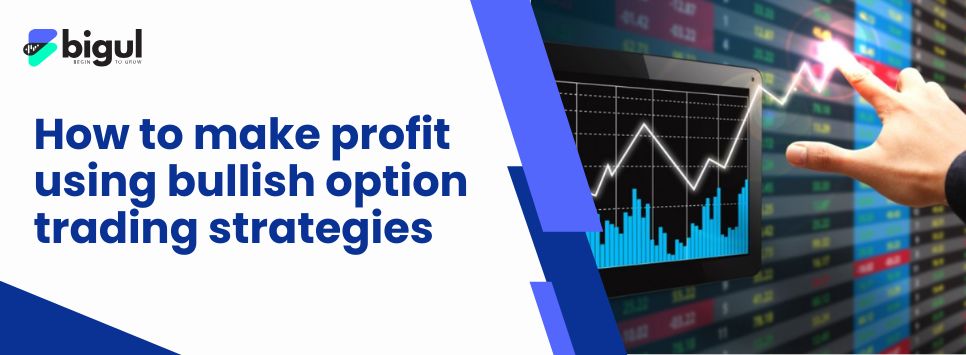Did you know that options trading strategies can make or break your investment portfolio? A startling 9 out of 10 individual traders in the equity Futures and Options Segment incur net losses. Even more concerning, these loss-makers register average net trading losses close to Rs 50,000 and spend an additional 28% of those losses on transaction costs.
However, it doesn't have to be this way. While buying calls is straightforward, it carries the significant risk of expiring worthless, resulting in total investment loss. In fact, even traders who make net profits often spend between 15% and 50% of those profits on transaction costs. This is why understanding different types of option strategies is crucial for long-term success.
Bullish options strategies, for instance, are ideal when you expect asset prices to rise. Additionally, such techniques as bull call spread constrain risk to past cost and commissions but have defined potential profits. Meanwhile, the bull put spread writes upfront credit, thus making it very popular among established traders.
Ultimately, we believe that with the right knowledge and approach, you can navigate the options market more effectively. In this guide, we'll share our expert trading tricks and reveal the best options and strategies that actually work, whether you're looking to minimise risk, maximise returns, or find the best strategy for option trading that suits your specific goals.
Also Read | What you Need to Know About Option Trading & Strategies
What Makes an Options Strategy Profitable
The difference between profitable and unprofitable options trading often comes down to three critical factors. Let's examine each component that contributes to a winning strategy.
Understanding market direction and volatility
Successful options traders don't guess—they analyse market direction using indicators like the Put-Call Ratio (PCR). From historical data, we can learn that if PCR values rise, Nifty drops and vice versa. Besides, the VIX (volatility index) is a good market direction indicator, and sharp VIX value variations correspond to possible trend reversals in the market.
Volatility directly influences option premiums—high volatility leads to higher premiums as the market anticipates larger price swings. During periods of economic uncertainty, such as the 2008 financial crisis, option premiums surged as market volatility spiked. Consequently, different volatility environments demand different strategies: high volatility favours long straddles, whereas low volatility works better with iron condors and covered calls.
Balancing risk and reward
Finding the right balance between potential gains and losses forms the foundation of profitable options strategies. Many traders aim for a risk-reward ratio of at least 1:3, risking Rs 8,438 to gain Rs 25,314 potentially. Nevertheless, this ratio alone isn't sufficient—you must also consider the probability of success.
A strategy that has a promising risk-reward, although it is a low probability, will not offer expected returns. On the contrary, a strategy that has a gloomy risk-to-reward ratio, but high success probability, may be appealing as well. Your view of market trends, financial objectives, and personal willingness to take risks all have an effect on the ideal balance for you.
Importance of timing and entry points
The question of when one can get rid of what is called time decay is significantly relevant to the profitability of the time decay. It is how much value the option loses as it closes the date of expiration. This decay accelerates with nearness to expiration. Time decay, the Greek value Theta (Θ) enables, option traders to measure, computed as a dollar change in premium per day towards the expiration.Strike price selection relative to the underlying asset's price also affects profitability. At-the-money options have the greatest time value but are most vulnerable to time decay. Comparatively, deep in-the-money options have less time value due to their dominant intrinsic value.
By mastering these three elements, you'll develop options trading strategies that consistently outperform random speculation.
Why Use Bullish and Neutral Option Strategies
The difference between the successful traders and those who lose is selecting the right trading strategies at the right time.
Let's understand when to use bullish option strategies for maximum effectiveness.
When to use bullish strategies
Bullish tactics are brilliant when you expect a rise in the price of the underlying asset. These approaches usually entail the use of purchases of calls or sellers of puts with different strike prices. I suggest the usage of bullish strategies first of all at the phase of economic rise, upward reporting from the companies or technical bursts.
The most effective bullish strategies include long calls for maximum profit potential and bull call spreads that reduce cost through selling higher strike calls. Notably, a bull put spread creates credit while still capitalising on upward price movement. For traders with stronger bullish convictions, the synthetic call offers unlimited profit potential while limiting downside risk to just the premium amount.
When to use neutral strategies
Unlike directional approaches, neutral strategies profit regardless of market direction—they thrive on volatility (or lack thereof) rather than price movement. These techniques work exceptionally well in sideways markets, during consolidation periods, or when facing uncertain economic conditions.
Consider implementing neutral strategies when volatility is low to moderate with expected range-bound movement. The iron condor, for instance, generates profit from limited volatility. Alternatively, straddles and strangles offer profit potential whether prices move up or down, making them suitable for uncertain markets with anticipated volatility.
Avoiding common beginner mistakes
Understanding common pitfalls is essential in option trading as sometimes experienced traders make mistakes. Let's understand what they are
-
Strategy misalignment: Ensure your strategy matches your market outlook regarding both direction and timeframe
-
Ignoring volatility: High implied volatility makes options expensive, favoring credit strategies; low volatility makes options cheaper, favouring debit strategies.
-
Neglecting probability: Consider statistical probabilities of success, not just potential returns
-
Poor strike selection: Cheaper isn't always better—examine delta values to understand the probability of profitability
-
Trading without a plan: Develop clear entry/exit guidelines before trading to remove emotional decision-making
By mastering when to deploy bullish versus neutral strategies, you'll dramatically improve your odds of consistent options trading success.
9 Expert Options Trading Strategies That Work
Lets understand the 9 battle-tested approaches which could provide reliable frameworks for various trading scenarios
1. Long Call
When you're strongly bullish on a stock, then buying a call option will give you the right to purchase those shares at a fixed strike price before expiration. This strategy helps to offer unlimited profit potential with risk limited to the premium paid.
2. Short Put
It is selling puts in cases where price drops below the strike price. This strategy assists in the generation of premiums with the acquisition of stocks at a lower effective price. At Rs 2025.13, effectively reducing your purchase price if assigned, a stock trade of Rs 2278.27 and a short put trade of Rs 2109.51 delivering Rs 84.38 premium.
3. Bull Call Spread
By buying a lower-strike call and selling a higher-strike call with identical expiration dates, you can create a Bull Call Spread strategy with defined risk and reward. Profit is maximised if the difference between the strike prices is taken, less the net cost. For example, purchase of a Rs4219.02 call and sale of a Rs 4640.92 call may cost Rs 84.38 per share whether with potential gains up to Rs 337.52 per share.
4. Bull Put Spread
This credit spread involves selling a higher-strike put and buying a lower-strike put with the same expiration. You receive an upfront premium while benefiting from neutral to bullish price action. The maximum profit equals the net premium received, realised when the stock closes above the higher strike price at expiration.
5. Bull Ratio Spread
Consisting of one long in-the-money call and two short out-of-the-money calls with identical expiration dates, this strategy benefits from slight price increases. Typically established for a credit, it reaches maximum profit when the stock closes at the short call strike at expiration.
6. Short Bull Ratio Spread
This strategy is to purchase at-the-money calls and fewer in-the-money calls with the same expiration date. It provides profit opportunities as the stock goes up, in most cases at no additional charge. For instance, at a cost of Rs44 per basis point, three calls can be purchased, and one can be sold for Rs 41, thus having unlimited potential before QQQQ exceeds Rs47.
7. Bull Butterfly Spread
Created by buying one lower-strike call, selling two middle-strike calls, and buying one higher-strike call (all equidistant), this approach profits from neutral price action. The maximum profit occurs when the stock closes exactly at the middle strike price at expiration.
8. Bull Condor Spread
Analogous to the butterfly spread but differing by four different strike prices, this technique allows a wider profit zone with a very slight decrease in maximum possible return. An Approximate bullish/bearish call spread, it maximises profits when the stock price stays within a specified range at expiration.
9. Bull Call Ladder Spread
This three-legged strategy involves buying at-the-money calls and selling two higher-strike calls with successively higher strikes. Initially, this reduces the cost of establishing a bullish position while maintaining significant upside potential until the highest strike price.
How to Choose the Best Strategy for Your Goals
Choosing the right Option trading strategy involves understanding your personal goals first. The right approach for the traders with risk assessment and current market conditions, will help to achieve the goals.
Assessing your risk tolerance
Risk tolerance represents your willingness and ability to accept potential losses for higher returns. Your financial situation significantly influences this tolerance—traders with secure finances typically demonstrate higher risk tolerance compared to those with limited capital.
Consider these factors when evaluating your risk tolerance:
-
Financial situation (income, savings, obligations)
-
Investment experience and emotional resilience
-
The time horizon until financial goals must be met
Many professional traders recommend dedicating only 1-2% of capital to any single position. For conservative strategies, consider 0.5-1%, whereas aggressive approaches might use above 2% per position. Several online assessment tools can help determine your risk profile, including questionnaires from financial institutions that estimate appropriate asset allocations based on your responses.
Matching strategy to market outlook
Every option's strategy performs best under specific market conditions. After establishing your risk tolerance, examine your market outlook—bullish, bearish, or neutral.
For bullish outlooks, positive delta strategies work best. Bearish conditions favour negative delta approaches. When expecting sideways movement, near-zero delta strategies that profit from time decay or volatility changes make sense.
The volatility environment equally affects strategy selection. High volatility environments favour positive vega strategies (buying options), while decreasing volatility environments benefit negative vega strategies (selling options).
Factoring in capital and experience level
Your available capital directly impacts which strategies you can implement effectively. Options selling strategies generally require a higher margin or premium. Accordingly, traders with smaller accounts should begin with less capital-intensive approaches.
Experience level should likewise guide your strategy choices. Beginners benefit from starting with simpler strategies like covered calls or cash-secured puts. More complex strategies, such as spreads and collars, require multiple transactions, and although they limit risk, they often cap potential returns as well.
Time frame considerations also matter—shorter-term strategies face accelerated time decay but offer higher price acceleration potential. Conversely, longer-term approaches experience less time decay but provide reduced price acceleration.
Conclusion
Options trading admittedly promises huge profit opportunities, if approached with knowledge and discipline.. Remember, nowhere in the pages of options trading will you hear anyone say that they are successful by accident. Instead, it is the product of choosing strategies that are consistent with both your market outlook and your personal tolerance for risk. For example, bullish strategies work better on bullish markets, while neutral strategies work better in sideways markets. As such, traders who align their strategy with the prevailing conditions always beat traders who apply the same strategy regardless of the market’s state.
Time decay affects all option positions; therefore, understanding how and when this acceleration occurs helps determine optimal entry and exit points.
Lastly, risk management remains paramount. While tempted by the prospect of unlimited profit from the presence of such strategies, professional traders tend to limit their positions by 1-2% of their total capital. To this end, this discipline, together with a careful analysis of the market and selection of strategies, paves the way for long-term success in options trading.. Undoubtedly, with practice and patience, you can develop a profitable options trading approach that works for your specific goals and circumstances.
FAQs
Q1. What is considered the most effective options trading strategy?
While there's no single "best" strategy, the Bull Call Spread is often regarded as highly effective. It involves buying and selling call options at different strike prices to profit from slight price increases while limiting risks.
Q2. What's a key tip for successful options trading?
A key tip is to ensure your plan fits your market outlook. If you believe prices are going to rise, buy call options or sell put options; if you think prices are likely to level off, sell options and buy put options or sell call options if you believe prices will fall.
Q3. How should I choose the right options trading strategy?
Select a strategy based on your risk tolerance, market outlook, available capital, and experience level. For instance, beginners might start with simpler strategies like covered calls, while more experienced traders could explore complex spreads.
Q4. What role does risk management play in options trading?
Risk management is absolutely necessary in option trading. Various professional traders typically limit sizes to 1-2% of their total capital per trade. This helps them to have strong risk management with long-term success options.
Also Read | Calendar Spread Options Strategy: A Guide for Options Traders









.jpg)
.jpg)
